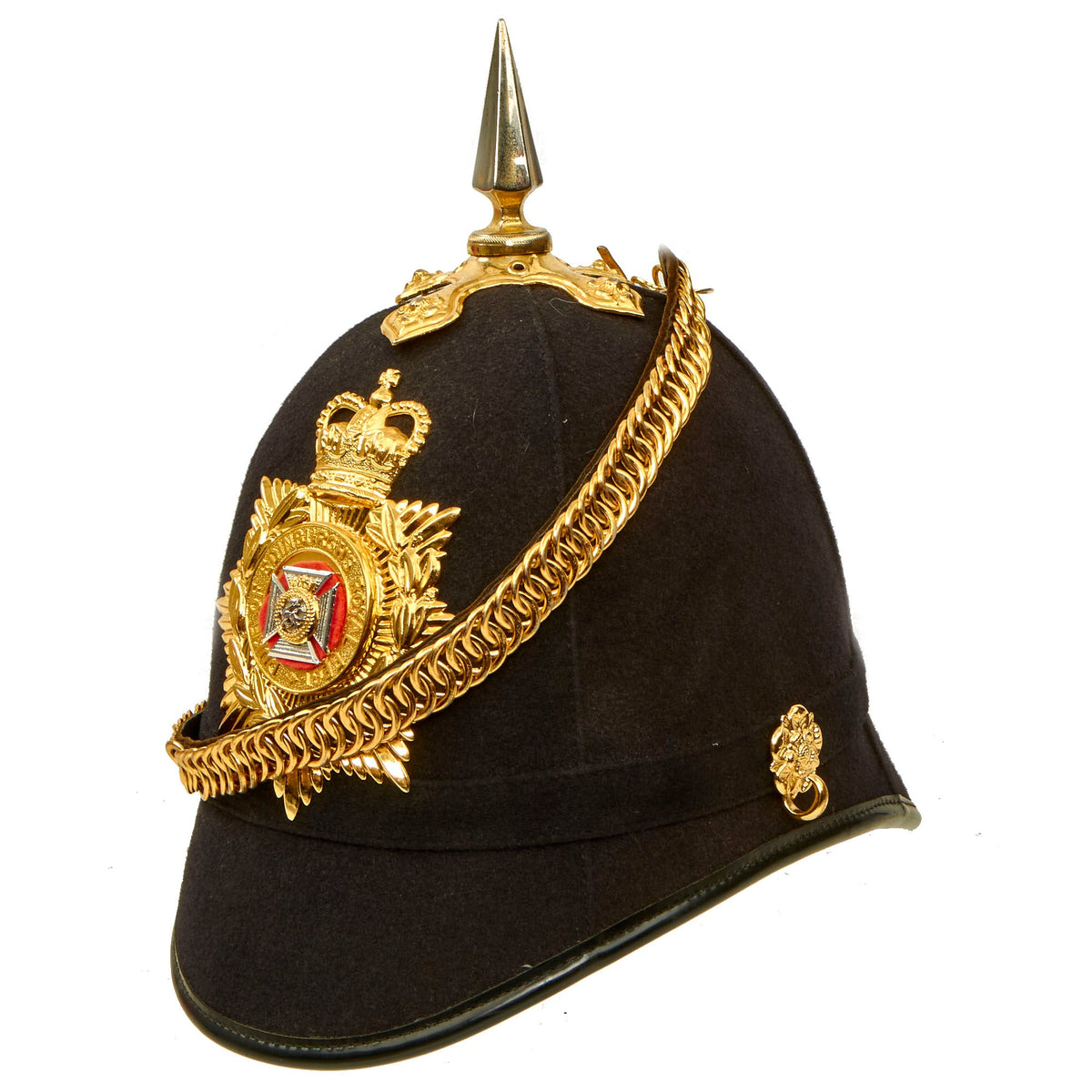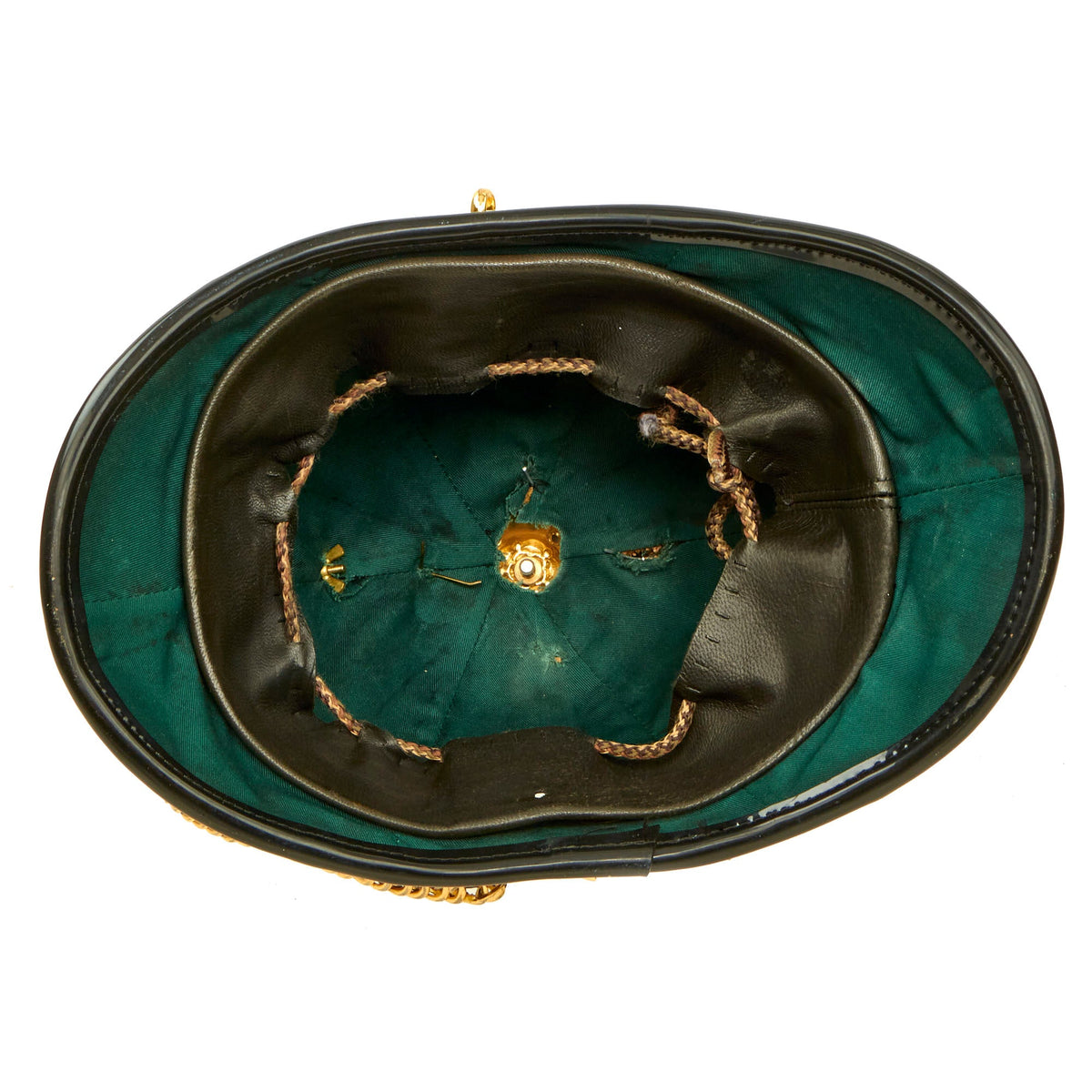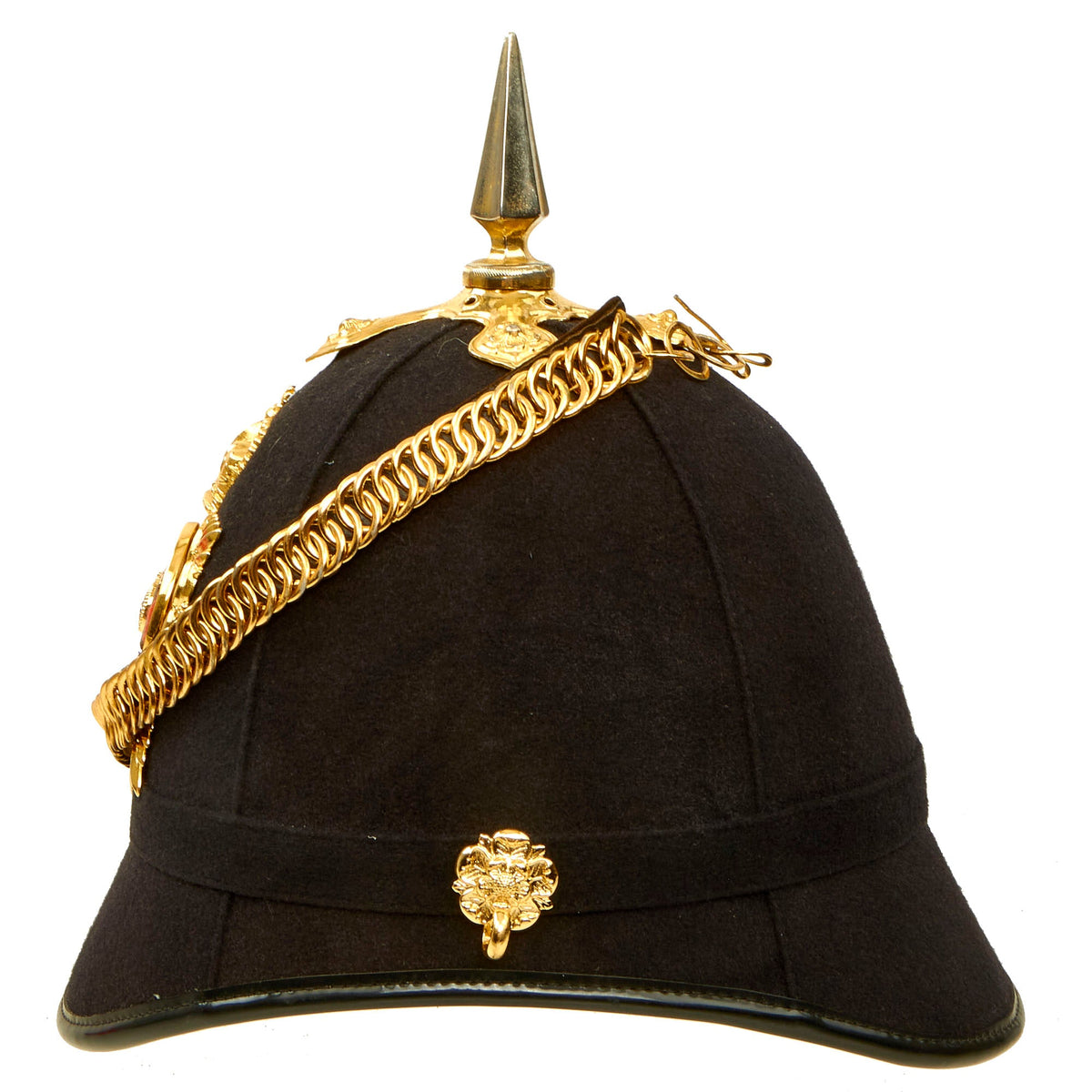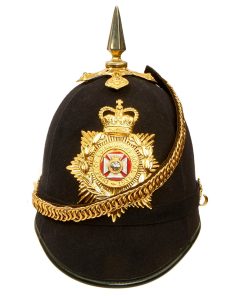Original British Mid 20th Century Duke of Edinburgh’s Royal Regiment Officer Blue Cloth Spike Dress Helmet Original Items
$ 295,00 $ 118,00
Original Item: Only One Available. This is a slightly used but solid condition 1960s era British Army Officer Blue Cloth Spiked helmet which is complete with its spiked finial and scaled chinstrap. The chin strap lugs and spike base ends are all properly adorned with embossed roses. This helmet has gilt brass mounts used on all regular Army helmets.
The front of the helmet has the correct regiment plate for DUKE OF EDINBURGH’S ROYAL REGIMENT. Body consists of cork covered with blue wool, trimmed with leather. Liner is black leather and is lined with green cloth.
The helmet is in fantastic condition for its age. Showing signs of honest use, and wear from storage and handling, but there are some issues such as loose fittings which can be tightened. Overall, this is an excellent example that is perfect for the collector of mid 20th Century British Militaria.
The regiment was formed on 9 June 1959 after defence cuts implemented in the late 1950s saw the amalgamation of the Royal Berkshire Regiment (Princess Charlotte of Wales’s) and Wiltshire Regiment (Duke of Edinburgh’s), forming the Duke of Edinburgh’s Royal Regiment (Berkshire and Wiltshire). The amalgamation parade to create the new regiment took place at Albany Barracks, Isle of Wight, when it also received its first set of Colours, presented by its Colonel-in-Chief, the Prince Philip, Duke of Edinburgh.
Until the early 1980s, the regiment’s administrative headquarters (RHQ) was at Brock Barracks, Reading, Berkshire, with a secondary or subsidiary headquarters at Le Marchant Barracks, Devizes, Wiltshire, but by 1982 a single RHQ had been permanently established in the Cathedral Close at Salisbury, Wiltshire, with the DERR regimental museum, – including the museum collections of the former Royal Berkshire Regiment and the Wiltshire Regiment – established on the ground floor of the same historic building, which had for several centuries been known locally as The Wardrobe.
The regimental badge of the new regiment was a silver cross patee (from the badge of the former Wiltshire Regiment), at the centre of which was a silver Chinese-style dragon (from the badge of the former Royal Berkshire Regiment). The Chinese dragon was surrounded by a gilt/gold double coil of naval rope (commemorating the service of the former regiments’ service as marines, especially that of the 49th Regiment of Foot at the Battle of Copenhagen in 1801). This rope coil was surmounted by the ducal coronet of the regiment’s Colonel-in-Chief in gilt/gold. The badge was invariably set upon a piece of red material known as the Brandywine Flash (commemorating the regiment’s action at the Battle of Brandywine in 1777, during the American Revolutionary War). This red backing was configured as a square (with the red colour showing between the four arms of the cross patee) where the badge was worn as a collar badge or on a peaked cap, but as an inverted triangle approximately 2 X 2.5 inches in size where it was worn on the beret.
The first posting for the 1st Battalion (1 DERR) in 1959 was in Tidworth, Wiltshire and it was from there in June 1960 that B Company arrived in the Bahamas to augment the in-place garrison unit in the Caribbean, the 1st Battalion the Royal Hampshire Regiment (1 R HAMPS). The following year, ethnic violence in British Guiana saw 1 DERR send a company to assist the re-establishment of order.[4] In December 1962 the battalion arrived in Malta for a deployment that would last just over three years.[4] While based there, 1 DERR deployed to Cyprus in February 1964, a month before the establishment of the United Nations Peacekeeping Force in Cyprus (UNIFICYP), returning to Malta in April, although subsequently the battalion did carry out further operational deployments to Cyprus.[4] Malta became independent from Great Britain on 21 September 1964 and the battalion fulfilled a major role in the ceremonial parade and associated events staged for this occasion. In January 1966, 1 DERR arrived in Minden, West Germany as part of the British Army of the Rhine (BAOR) for a three-year posting as a mechanized infantry battalion.[4] In West Germany the battalion formed part of the 11th Infantry Brigade. From that location its soldiers trained in Libya, Norway, and France. The battalion moved to Catterick in June 1969, and thereafter successive companies carried out deployments to the Central American colony of British Honduras. In addition, A Company trained in Malaysia in 1969 and the entire battalion trained in Canada in 1970. In August 1969 C Company was sent to Derry to reinforce the 1st Battalion of the Queen’s Regiment (1 QUEENS) at the start of many years of violent turmoil that were in due course termed The Troubles. C Company remained in Northern Ireland until December. The following year, B Company was dispatched to Belfast to support 1st Battalion the Royal Scots (1 RS). In 1971 1 DERR deployed to Derry for its first tour of duty in Northern Ireland as a complete battalion.
Fast Shipping with Professional Packaging
Thanks to our longstanding association with UPS FedEx DHL, and other major international carriers, we are able to provide a range of shipping options. Our warehouse staff is expertly trained and will wrap your products according to our exact and precise specifications. Prior to shipping, your goods will be thoroughly examined and securely secured. We ship to thousands clients each day across multiple countries. This shows how we're dedicated to be the largest retailer on the internet. Warehouses and distribution centres can be located throughout Europe as well as the USA.
Note: Orders with more than one item will be assigned a processing date depending on the item.
Before shipping before shipping, we'll conduct a thorough inspection of the items you have ordered. Today, the majority of orders will be delivered within 48 hours. The delivery time will be between 3-7 days.
Returns
The stock is dynamic and we cannot completely manage it because multiple stakeholders are involved, including our factory and warehouse. So the actual stock may alter at any time. It's possible that you may not receive your order once the order has been made.
Our policy is valid for a period of 30 days. If you don't receive the product within 30 days, we are not able to issue a refund or an exchange.
You can only return an item if it is unused and in the same state as the day you received it. You must have the item in its original packaging.
Related products
Uncategorized
Uncategorized
Uncategorized
Armoured Fighting Vehicles of the World: AFVs of World War One (Hardcover Book) New Made Items
Uncategorized
Uncategorized
Uncategorized
Uncategorized
Uncategorized
Uncategorized
Uncategorized
Uncategorized
Uncategorized
Uncategorized
Uncategorized
Uncategorized
Uncategorized
Angolan Rebel 1970s era 60mm Inert Display Mortar from Angolan Civil War Original Items
Uncategorized
Armored Burgonet Helmet & Polearm from Scottish Castle Leith Hall Circa 1700 Original Items
Uncategorized
Uncategorized












































































